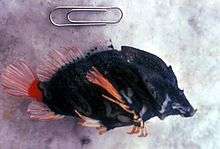Grunt sculpin
| Grunt sculpin | |
|---|---|
 | |
| Scientific classification | |
| Kingdom: | Animalia |
| Phylum: | Chordata |
| Class: | Actinopterygii |
| Order: | Scorpaeniformes |
| Family: | Rhamphocottidae T. N. Gill, 1889 |
| Genus: | Rhamphocottus Günther, 1874 |
| Species: | R. richardsonii |
| Binomial name | |
| Rhamphocottus richardsonii Günther, 1874 | |
The grunt sculpin or grunt-fish, Rhamphocottus richardsonii, is the only member of the fish family Rhamphocottidae. It is native to temperate coastal waters of the North Pacific, from Japan to Alaska and south to California where it inhabits tide pools, rocky areas, and sandy bottoms at depths of up to 165 metres. It uses its spiny pectoral fins to crawl over the sea floor. It grows up to 9 cm in length. It frequently takes shelter in discarded bottles and cans, as well as the empty shells, such as those of the giant barnacle (Balanus nubilis). During reproduction, the female chases a male into a rock crevice and keeps him there until she lays her eggs.

Grunt Sculpin. Courtesy: U.S. Fish & Wildlife Service
References
- "Rhamphocottus richardsonii". Integrated Taxonomic Information System. Retrieved 24 January 2006.
- Froese, Rainer, and Daniel Pauly, eds. (2006). "Rhamphocottidae" in FishBase. February 2006 version.
- Froese, Rainer and Pauly, Daniel, eds. (2006). "Rhamphocottus richardsonii" in FishBase. February 2006 version.
This article is issued from Wikipedia - version of the Sunday, February 14, 2016. The text is available under the Creative Commons Attribution/Share Alike but additional terms may apply for the media files.